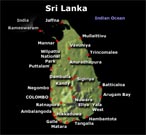Health issues loom for Sri Lanka's displaced
 Colombo - Scorching sun, swarming flies and dusty terrain greet visitors to camps in northern Sri Lanka where tens of thousands of civilians are housed after being displaced in the country's civil war.
Colombo - Scorching sun, swarming flies and dusty terrain greet visitors to camps in northern Sri Lanka where tens of thousands of civilians are housed after being displaced in the country's civil war.
Flies are rampant and hygiene is a life-threatening issue, a visitor to the camps told the German Press Agency dpa. "The flies are so infinite we saw merchants sitting inside makeshift nets selling things."
Toilet facilities are also inadequate. "In one camp we saw some of the tents been removed and the area used as open defecating areas. On both sides of the road you could see human waste," the report added.
A United Nations report on the conditions in the camps said there were currently only 9,215 toilets, less than the required 15,000.
More than two months have lapsed since the government declared victory over the Tamil rebels, but government authorities, UN agencies and aid groups are still struggling to provide facilities for the 280,000 refugees in the camps.
Most of the camps are located in Vavuniya, 254 kilometres north of Colombo, where jungles were cleared for tents and temporary shelters, with three to four families sharing each shelter.
UN agencies, as well as local and foreign non-governmental workers who were initially granted only restricted access, are now allowed into the camps, but the government still controls their movements.
While the latest UN statistics state some improvement over the past weeks, health concerns prevail, with cases of diarrhea, meningitis, encephalitis and chickenpox reported.
"The government may be trying to do its best, but the best seems to be not sufficient in these camps," said an NGO worker, who asked not to be named.
Dr Hemantha Herath, health coordinator of the camps, confirmed that diarrhea and encephalitis are still prevalent.
Over the past week, 14 new encephalitis cases were detected in a hospital where the displaced are being treated, he said.
A medical officer working with the authorities providing relief services, who asked to remain anonymous, said there was a also a noticeable number of people suffering from some form of depression.
"Many have complained of lack of sleep, body pains and headaches. These are early signs of depression," the doctor said.
Dr Vasana Kiridana, the consultant paediatrician of Vavuniya hospital where many of the displaced are being treated, said nearly 20 per cent of the refugees are children and many of them suffer from malnutrition, a result of living under difficult conditions.
"Acute malnutrition due to severe starvation has been identified as a major health concern. A significant proportion of these children are suffering from extreme malnutrition which requires in-hospital care with meticulous monitoring and feeding to save their fragile lives," Dr Kiridana said.
However, government authorities in charge of the refugees' welfare are also concerned with security issues and funding challenges.
Most of the camp inmates have been living in areas controlled by the rebel Liberation Tigers of Tamil Eelam (LTTE) for over two decades. Some are relatives of killed rebels, while others may have been active rebels.
The security forces continue their screening process and already some 10,000 people said to be LTTE fighters have been segregated to undergo rehabilitation while others are to face court charges.
Sri Lanka's government spends 245,000 dollars a day to feed the displaced, not counting the costs of other facilities, amounting to a major drain on the island's finances.
Colombo has reiterated plans to resettle more than 80 per cent of the displaced before the end of the year in their original villages, but NGO workers say it will be a difficult task as some of the areas still need to be cleared of landmines.
Government and aid workers appear to be caught in a dilemma over whether to improve the shelter conditions or focus on the resettlement programmes.
Some of the refugees were driven from their homes almost two decades ago and have been living in camps with little hope for return since. However, with the end of the war, their chances for resettling in their home villages seems to have improved. (dpa)